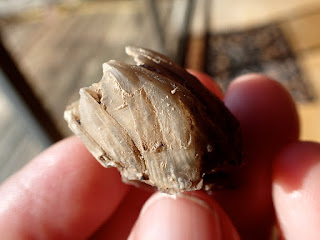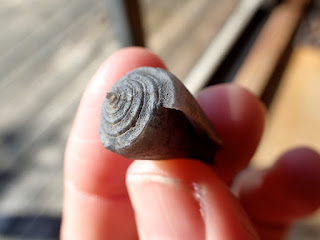Or...
I hope you like shells.
I hope you like shells.
I don't dislike shells
but that's not what I'm looking for when I'm fossil hunting.
I recently went on an expedition to the Caloosahatchee River with Miss Vickie, Mike from FCOLC, and his buddy, Keith. Mike had been flossin' at the recent fossil festival, showing off a box of amazing light colored makos that his uncle found along the banks of the Caloosahatchee River in south Florida.
Are you kidding me?! I'm in!!!
Vickie and I met at the appointed place at the usual early appointed hour
and due to a faulty brake light wire, she worked some down home magic
to deal with the situation:
The boat yard where we met was a very interesting place, a little world of its own, completely hidden from the main road:
To me, it looked a bit more like a boat graveyard but I was assured that some of the boats would see water again. Some day.
Hunting this river is very different from digging in the Peace.
Much of the Caloosahatchee has been dredged to accommodate large boats so digging and screening isn't possible. Instead, searching is done along the banks, where new material is constantly being dislodged by boat waves, and checking out exposures of spoil piles
where dredged material has been dumped.

It's a much more relaxed pace.
where dredged material has been dumped.

It's a much more relaxed pace.
Especially relaxed since we didn't have to spend much time picking up fossils.
The USGS web site states that the mollusk bearing sediments of southern Florida contain some of the most abundant and diverse fossil faunas in the world but our hunting yielded more in the "dearth" category than "abundance".
Tempers flared.

Luckily, there were no serious shovel injuries.
So...besides this bullet,

and this horse tooth and giant armadillo scute,

I found shells.
Old shells.

I have a fossil friend who is a shell expert and he helped me with the ID's.
I like the bivalves that have both sides and the plicatula marginata had a surprise when I put it under the black light:

I'm glad, as always, to say that I took part in a new experience
and the Caloosahatchee might be a good spot to check out again
when the Peace River is too high to hunt.
I'll end with some close ups of the shells I kept and some more info about the Caloosahatchee formation of Florida.




From the USGS web site:
The USGS web site states that the mollusk bearing sediments of southern Florida contain some of the most abundant and diverse fossil faunas in the world but our hunting yielded more in the "dearth" category than "abundance".
Tempers flared.

Luckily, there were no serious shovel injuries.
So...besides this bullet,

and this horse tooth and giant armadillo scute,

I found shells.
Old shells.

I have a fossil friend who is a shell expert and he helped me with the ID's.
I like the bivalves that have both sides and the plicatula marginata had a surprise when I put it under the black light:

I'm glad, as always, to say that I took part in a new experience
and the Caloosahatchee might be a good spot to check out again
when the Peace River is too high to hunt.
I'll end with some close ups of the shells I kept and some more info about the Caloosahatchee formation of Florida.




From the USGS web site:
Shelly sediments of Plio-Pleistocene age (Pliocene/Pleistocene) at surface, covers 9 % of this area
Shelly sediments of Plio-Pleistocene age - Tertiary-Quaternary Fossiliferous Sediments of Southern Florida - Molluskbearing sediments of southern Florida contain some of the most abundant and diverse fossil faunas in the world. The origin of these accumulations of fossil mollusks is imprecisely known (Allmon, 1992). The shell beds have attracted much attention due to the abundance and preservation of the fossils but the biostratigraphy and lithostratigraphy of the units has not been well defined (Scott, 1992). Scott and Wingard (1995) discussed the problems associated with biostratigraphy and lithostratigraphy of the Plio-Pleistocene in southern Florida. These "formations" are biostratigraphic units. The "formations" previously recognized within the latest Tertiary-Quaternary section of southern Florida include the latest Pliocene - early Pleistocene Caloosahatchee Formation, the early Pleistocene Bermont formation (informal) and the late Pleistocene Fort Thompson Formation. This section consists of fossiliferous sands and carbonates. The identification of these units is problematic unless the significant molluscan species are recognized. Often exposures are not extensive enough to facilitate the collection of representative faunal samples to properly discern the biostratigraphic identification of the formation. In an attempt to alleviate the inherent problems in the biostratigraphic recognition of lithostratigraphic units, Scott (1992) suggested grouping the latest Pliocene through late Pleistocene Caloosahatchee, Bermont and Fort Thompson Formations in to a single lithostratigraphic entity, the Okeechobee formation (informal). In mapping the shelly sands and carbonates, a generalized grouping as Tertiary-Quaternary shell units (TQsu) was utilized. This is equivalent to the informal Okeechobee formation. The distribution of the Caloosahatchee and Fort Thompson Formation are shown on previous geologic maps by Cooke (1945), Vernon and Puri (1964) and Brooks (1982). The Nashua Formation occurs within the Pliocene - Pleistocene in northern Florida. However, it crops out or is near the surface is an area too small to be shown on a map of this scale. Lithologically these sediments are complex, varying from unconsolidated, variably calcareous and fossiliferous quartz sands to well indurated, sandy, fossiliferous limestones (both marine and freshwater). Clayey sands and sandy clays are present. These sediments form part of the surficial aquifer system

































